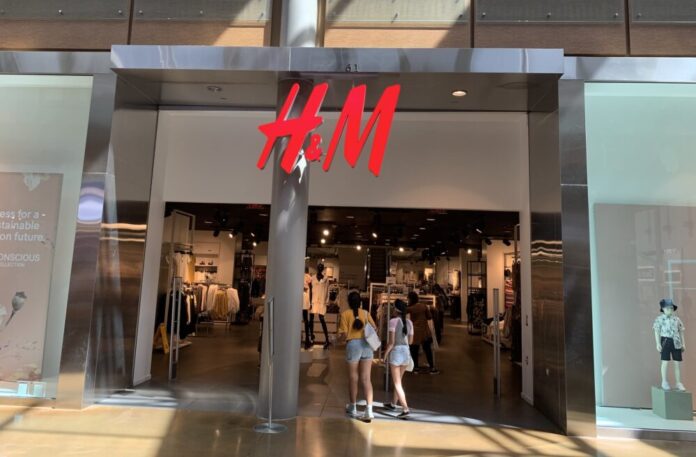
“When the economy is bad, I don’t think we can compete with fast fashion,” said Nissa Quick, the co-owner of a small business. “Most people have to make a choice on where their money goes. They may love the idea of supporting a small business, but it’s not financially feasible.”
Quick co-owns the small Etsy business NissaLisa.
While fast fashion companies historically prioritized speed and affordability over sustainability and ethical practices, these companies are now changing their production processes in response to the sustainability trend.
The allure of fast fashion lies in its ability to offer the latest fads at affordable prices, catering to the ever-changing tastes of consumers. Brands like Shein, Zara and H&M mastered the art of rapid production and distribution, capitalizing on consumer demand for instant gratification.
A combination of media coverage, scientific research, environmental disasters, advocacy efforts, government policies and corporate initiatives contributed to global environmental awareness. As consumers become more informed and conscientious, the demand for alternatives to synthetic fibers grows.
Charyti Benjamin, a fast fashion customer, explains that while she still shops with brands like Shein, she has become more conscious of the practices and impact of fashion companies.
“I think it has a lot to do with me getting a little bit more knowledge about fast fashion and the harm it’s doing to the environment,” Benjamin said. “Shein being one of the biggest contributors of fast fashion has definitely changed my view of them.”
In 2019, a McKinsey & Company survey found that 66% of all participants and 75% of millennials consider sustainability when deciding to make a purchase.
Despite allegations of unsustainable practices, fast fashion continues to dominate consumer attention, overshadowing small businesses that prioritize sustainability in their branding.
As co-owner of the small Etsy business NissaLisa, Nissa Quick creates monster shirts and towels for children, relying on recycled fabrics. Customers even have the option of providing their own old fabrics that can be transformed into a new product.
“We provide a unique one-of-a-kind product, but that costs money,” Quick said. “Fast fashion may not create a unique one-of-a-kind product, but it’s affordable and immediate. The only reason we have stayed in business as long as we have is because we have other forms of income and have never acquired business debt.”
The fast fashion trend began in the 1970s as production moved to cheaper labor markets in China, Bangladesh, Vietnam and India. By the 1990s, it sped up with companies releasing new collections more frequently, sometimes as often as every few weeks.
The fast fashion industry relies on synthetic materials that lower costs but do not biodegrade easily, such as polyester, acrylic and nylon, negatively impacting the environment.
Polyester derives from petroleum, a nonrenewable fossil fuel. The production process releases significant carbon emissions. After use, polyester remains in landfills for decades, possibly even centuries, according to Council of Fashion Designers of America (CFDA) polyester fiber statement.
Textile Exchange reported polyester as the most used fiber worldwide, comprising 80% of all synthetic fiber usage.
Claude Vipperman, a Kennesaw State University assistant professor of art specializing in textiles and fashion, emphasized the role of polyester in the fast fashion industry.
“Polyester and man-made textiles certainly have their place in our world,” Vipperman said. “There are many companies that produce polyester and man-made textiles specifically to outperform anything else that’s out there.”
Vipperman explained natural fibers need to be taken care of and washed with the care instructions in mind. In contrast, man-made fibers, like polyester, are durable enough to be thrown in the washer and then worn immediately.
This durability, in conjunction with its abundance and low costs, makes polyester the obvious and only choice when it comes to textile decisions in the fashion industry.
“I definitely enjoyed the majority of my purchases from Shein,” said fast fashion consumer Charyti Benjamin. “For the most part, they are pretty good quality pieces. Every now and then you can get pieces that can be see-through, or the material is cheaper. But I really think it depends on what you get.”
As Shein’s market dominance persists, consumer experiences like Benjamin’s underscore the brand’s enduring popularity. Despite occasional quality concerns, Shein remains a significant player in the fast fashion industry.
In November 2022, Shein dominated the market share of the fast fashion industry with 50%, and H&M second with 16%, according to a Statista data report. Fashion Nova, Forever 21 and Zara made up the other shares.
Shein’s online presence, bolstered by over 5 million TikTok posts, outshone competitors like Zara, Fashion Nova, H&M and Forever 21 in social media engagement.
The COVID-19 pandemic accelerated the shift to online shopping, benefitting Shein, whose e-commerce sales surged from $571.2 billion in 2019 to $815.4 billion in 2020 according to the U.S. government’s Annual Retail Trade Survey (ARTS).

Despite encountering numerous controversies on its journey to prominence, Shein steadfastly retains its position as the leading fast fashion brand, according to Bloomberg. Through strategic timing and a robust social media presence, the company effectively engages its target audience, listening to their wants and maintaining its appeal.
On April 29, 2022, Shein launched EvoluShein by Design, an initiative by the company to, “[accelerate] the use of preferred materials and scaling responsible manufacturing processes,” in hopes of limiting negative environmental impact.
Shein emerged as a game-changer in the fast fashion industry, showcasing how companies, regardless of size, can transition from fast, temporary fads to ever-present trends that contend with not just fast fashion brands, but all other fashion companies.
This success is bolstered by Shein’s continuous engagement with its target audience on social media platforms such as TikTok and Instagram. Influencers and creators often share ‘haul videos‘ on TikTok, featuring their recent purchases from Shein and other fast fashion companies, contributing to the brand’s enduring popularity and reach.
Haul videos primarily consist of large orders to showcase the affordability of the products, encouraging viewers to consider bulk purchases. Often, the creators also model the apparel they’ve acquired to demonstrate their trendy style choices.
These bulk orders typically range from 30-40 different items, as many products available on Shein are under $10 given the variety of clothes. There are also instances where customers can find basic shirts, shorts and accessories for under $2 per item.
“Usually, I choose Shein because of the things I see on social media and also because it’s a much cheaper option,” Benjamin said.
Professor Claude Vipperman explained the likelihood of fast fashion switching to organic materials on a large scale is not likely because polyester is so embedded in the fast fashion industry.
Shein may never switch to a primary material other than polyester, though many materials are better for the environment. However, the EvoluShein line combines materials, meshing polyester with organic materials so less polyester is produced.
A key feature of EvoluShein is its commitment to using recycled polyester along with other recycled materials not only in its products but also in its packaging.
“Polyester is plastic, and plastic melts, so they can literally melt it and reuse the polyester,” Vipperman said. “Same thing with plastic bottles. It’s a similar concept, and that’s probably where they got the idea.”
Aside from repurposing, the next best thing fast fashion companies can do to minimize environmental harm in an industry based on synthetic fabrics is to reduce waste, which comes with its own challenges.
Brittany Johnson, costume shop manager, explained the efforts required for sustainable apparel practices even on a smaller scale. Her costume shop receives frequent donations. Johnson and her team use what they can from these donations, but, more often than not, the donations are not needed, which results in the transfer of more clothing to landfills.
“I have my ear to the ground with other shops that are trying to figure out how to fix this problem,” Johnson said. “There are some companies that will take your fabric scraps, but when I go to research them, they’re already shut down.”
Amidst the evolving landscape of consumer preferences and corporate responsibility, the fashion industry finds itself at a critical juncture navigating the delicate balance between profit-driven decisions and sustainable practices.
“They have the money to make the sustainable changes they’re talking about,” Vipperman said. “Plus, they have that whole world market thing, where, if I had part of Shein stock as a stockholder, I would make sure that that’s the direction the company is taking or go elsewhere with my money.”
While the fast fashion industry grapples with environmental and ethical challenges, solutions are emerging. Embracing circular economy principles, such as recycling and upcycling, can minimize textile waste.
Additionally, prioritizing sustainable materials like organic cotton and recycled polyester reduces reliance on harmful fibers and enhances transparency in supply chains, empowering consumers to make informed choices and hold brands accountable for their actions.
“Empower your generation,” Vipperman said. “What is happening now is part of that consumer effect that businesses don’t pay attention to … I believe that the younger generation is truly driving this to change something that’s been really bad in the fashion industry forever that nobody was even really aware of until recently.”
For more from Fresh Take Georgia and the latest updates, follow us on Facebook and Twitter.
















